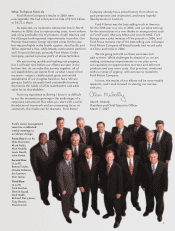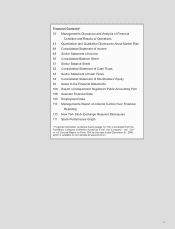Ford 2006 Annual Report Download - page 15
Download and view the complete annual report
Please find page 15 of the 2006 Ford annual report below. You can navigate through the pages in the report by either clicking on the pages listed below, or by using the keyword search tool below to find specific information within the annual report.
Management’s Discussion and Analysis of Financial Condition and Results of Operations
13
Overall, including ACH hourly employees, at December 31, 2006 we had about 89,000 hourly employees in North
America (including Canada and Mexico), which is down from about 99,500 employees at year-end 2005. By the end of
2008, our plan is to operate with between 55,000 to 60,000 hourly employees in North America.
Capacity alignment
We also intend to reduce and realign our vehicle assembly capacity to bring it more in line with demand and shifting
customer preferences. There are several ways to measure our vehicle assembly capacity, two of which are installed
capacity and manned capacity. Installed capacity refers to the physical capability of the plant and equipment to assemble
vehicles if fully manned. Manned capacity refers to the degree to which the installed capacity has been staffed. In
addition, in North America there generally exists the capability to work overtime or schedule downtime to adjust the
manned capacity in the short term to match sales.
In the longer term, a useful measure of capacity is maximum installed capacity. This reflects the full physical capacity
of the plant and equipment, including maximum overtime. In the shorter term, a useful measure is straight-time manned
capacity. This reflects the extent to which labor is being utilized to make the installed capacity capable of actually
assembling vehicles.
Since year-end 2005, we have reduced our North American maximum installed capacity (with all plants operating on
two shifts) and straight-time manned capacity from 4.8 million units and 3.6 million units, respectively, to 4.1 million units
and 3.4 million units, respectively. As indicated in the table below, our plan is to further reduce our North American
assembly capacity on both bases by the end of 2008. Our projected North American vehicle production divided by our
planned maximum installed assembly capacity of 3.6 million units results in a capacity utilization rate of 84% in 2008. Our
North American straight-time manned capacity utilization in 2008 is projected to be 100% as a result of plant idlings as
well as shift eliminations and line speed reductions. Reducing our manned capacity in this manner allows us to achieve
major cost savings and coordinates plant idlings with planned product changes, which we believe is the best economic
approach.
3URMHFWHG
&DSDFLW\0HDVXUH
$VVHPEO\
&DSDFLW\
PLOXQLWV
&DSDFLW\
8WLOL]DWLRQ
SHUFHQW
0D[LPXP,QVWDOOHG
6WUDLJKW7LPH0DQQHG
__________
* Based on a two-shift operating pattern
We plan to reduce our maximum installed assembly capacity in North America by the end of the decade so that it closely
matches projected sales of Ford, Lincoln and Mercury brand units.
As part of this reduction, we have announced plans to idle 16 North American manufacturing facilities, including seven
vehicle assembly plants, by the end of 2012. Of these, the following nine facilities have been or are planned to be idled
by the end of 2008:
x Atlanta Assembly Plant (idled in 2006);
x Batavia Transmission Plant (to be idled in 2008);
x Essex Engine Plant (to be idled in 2007);
x Maumee Stamping Plant (to be idled in 2008);
x Norfolk Assembly Plant (to be idled in 2007);
x St. Louis Assembly Plant (idled in 2006);
x Twin Cities Assembly Plant (to be idled in 2008);
x Windsor Casting Plant (to be idled in 2007); and
x Wixom Assembly Plant (to be idled in 2007).
























